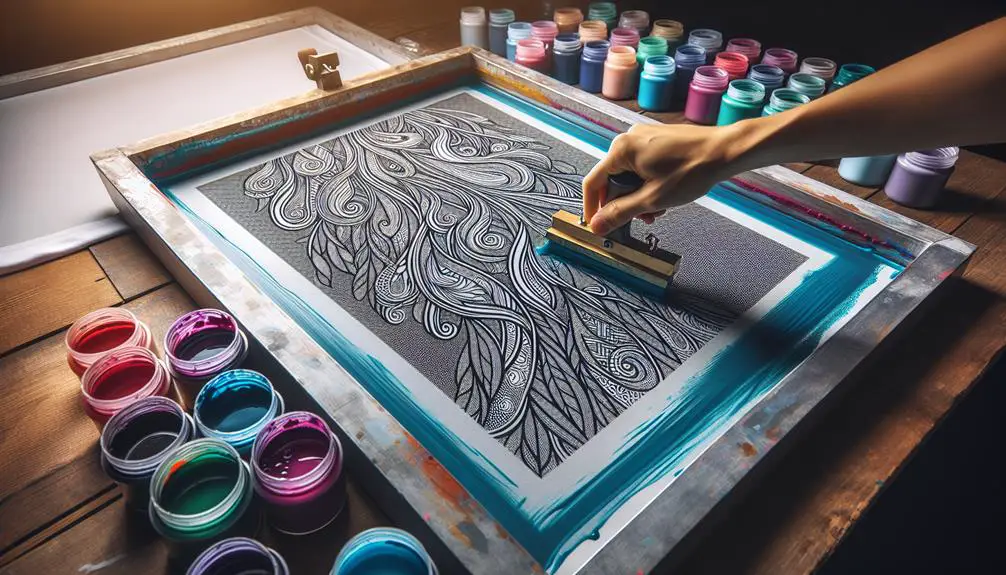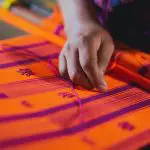Did you know that the global market for polyester fibers is projected to exceed 110 billion USD by 2025? That's a staggering figure, and it reflects just how pervasive this material has become in our daily lives, especially in the apparel sector.
As a professional in the screen printing industry, I've encountered numerous inquiries about whether it's feasible to silkscreen on polyester. While it's certainly possible, there are a handful of critical factors to contemplate, such as ink selection and fabric pre-treatment, to circumvent common issues like dye migration and ink cracking.
Let's explore some of these key considerations together, and I'll share insights on how to achieve prime results on polyester fabrics.
Table of Contents
Key Takeaways
- Silkscreen printing on polyester is possible using specialized inks like low bleed white inks to prevent dye migration.
- Proper pre-treatment of polyester fabric ensures optimal ink adhesion and enhances wash resistance.
- Controlling the curing process, especially temperature, is crucial for maintaining the quality of prints on moisture-wicking polyester.
- Special techniques, such as using a gray underbase or nylon bonding catalyst additives, help in achieving vivid and durable prints on polyester.
Understanding Polyester Challenges
Screen printing on polyester comes with its own set of challenges, from dye migration to ink cracking, making it important to choose the right materials and techniques. The core issue lies in the fact that polyester's unique properties can lead to dye migration, especially during the curing process. This happens around 300 degrees, which is important for setting the ink but, unfortunately, can also cause the ink colors to bleed or change, affecting the final print quality.
To navigate these hurdles, I've learned the importance of selecting specialized inks, such as Low Bleed white ink, which serves as an effective underbase to block dye migration on polyester fabric. This step is vital for ensuring that the vibrant colors of your design remain true to your vision.
Additionally, most inks used in screen printing aren't as stretchy as polyester spandex blends, which can lead to ink cracking if not addressed properly. Here, the choice of ink again plays a significant role. Water-based inks, for example, can offer a degree of flexibility that's more compatible with the stretchy nature of polyester, thereby reducing the risk of cracking. Getting these elements right ensures a high-quality finish and durability in screen printing on polyester.
Preparing for Silkscreen Printing
To start, it's important to pre-treat the polyester fabric to make sure the ink sticks well and the final print stands up to washing. Pre-treating isn't just about ensuring essential; it's also about optimizing the fabric's ability to display vibrant colors and fine details. This is where the choice of screen printing ink comes into play.
For polyester, specialized inks such as low bleed white inks are a game-changer. They serve as an underbase to block dye migration, a common issue with polyester that can muddy your design's crispness and clarity. Sometimes, I opt for gray underbase ink to neutralize dye migration further, though it might result in a slightly heavier print. But it's a trade-off I'm willing to make for the sake of precision and quality.
Achieving vibrant colors on polyester isn't just about the ink or the pre-treating process; curing plays a pivotal role too. Following the manufacturer's instructions for curing is important. It's the final step that locks everything in place, ensuring the durability and color fastness of the print. In silkscreen printing on polyester, every detail—from ink selection to curing—matters for that perfect finish.
Techniques and Materials
Several techniques and materials are essential when it comes to silkscreening on polyester, ensuring the final product is both durable and visually appealing. First off, using specialized inks designed for polyester is a game-changer. These inks are formulated to adhere better to the fabric's synthetic fibers, providing a vivid finish that withstands the test of time and many wash cycles.
The curing process is another critical aspect. Polyester's moisture-wicking properties can throw a wrench in the works, making precise temperature control vital. Too hot, and you risk damaging the fabric; too cool, and the ink won't cure properly. That's why I often rely on a heat press or conveyor dryer, tools that give me the control I need to ensure the ink sets just right.
Pre-treatment also plays a huge role in the success of silkscreening on polyester. It's all about preparing the fabric to receive the ink, ensuring the optimal adhesion and washability. And let's not forget about low bleed white inks, my secret weapon against dye migration. By laying down this underbase, I can keep colors from bleeding and maintain the sharpness and vibrancy of my designs.
Preventing Dye Migration
Dye migration in polyester, especially noticeable with white inks on dark fabrics, can be a real headache, but I've found effective ways to tackle this issue head-on. Understanding that dye migration occurs during curing at around 300 degrees, affecting ink colors and final print quality, I've learned that the key to preventing migration lies in controlling the curing temperature and choosing the right inks.
To start, I make sure to cure polyester fabrics under 320 degrees Fahrenheit. This is essential because polyester's properties make it prone to dye migration issues, particularly with white inks on dark colors. I've found that using poly inks that cure at lower temperatures significantly reduces the risk of dye migration.
Additionally, I've discovered that incorporating nylon bonding catalyst additives can lower the curing temperature even further. These additives help bond plastisol ink to polyester fibers, providing a solid barrier against dye migration. Whether I'm using water-based inks or plastisol inks, adding nylon bonding agents has been a game-changer in preventing migration and ensuring the longevity and quality of my prints on polyester. This approach hasn't only improved my printing on polyester but has also instilled confidence in my ability to produce high-quality, durable prints.
Comparing Fabrics for Printing
When choosing the best fabric for screen printing, it's important to understand how cotton and polyester differ in their properties and how these differences affect the printing process. Cotton, being a natural fiber, offers a straightforward canvas for screen printing, absorbing inks easily which allows for bright, durable designs. However, polyester presents its own set of challenges due to its synthetic nature, including moisture resistance which can complicate adhesion.
To make the choice clearer, consider these points:
- Dye Migration: Polyester, especially when blended with spandex, is prone to dye migration. This means colors can bleed during the curing process, potentially ruining the design. Cotton, on the other hand, doesn't suffer from this issue.
- Specialized Inks and Curing Methods: Printing on polyester often requires specialized inks and curing methods to ensure the print adheres properly and lasts. This isn't as much of a concern with cotton.
- Tri-blend T-Shirts: For those looking for a middle ground, tri-blend shirts combine polyester, cotton, and rayon. They offer the comfort of cotton, the durability of polyester, and better printability than polyester alone.
Understanding these differences helps in selecting the right fabric for your screen printing project, guaranteeing the quality and longevity of your designs.
Frequently Asked Questions
Can You Silk Screen on 100% Polyester?
Yes, I can silk screen on 100% polyester, but it requires specific inks and techniques to prevent dye migration. Pre-treating the fabric and using proper curing methods are key for high-quality, durable prints.
What Fabric Is Not Good for Screen Printing?
I've learned that polyester isn't great for screen printing due to its smooth, synthetic nature making ink adhesion tricky. Special techniques and inks are needed to guarantee vibrant, lasting prints on this challenging fabric.
Which Printing Is Best for Polyester Fabric?
I've found that screen printing with specialized inks, like low bleed white and gray underbase, works best for polyester. It guarantees vibrant colors, fine details, and durability, especially if you pre-treat the fabric properly.
Can You Screen Print on 50 Cotton 50 Polyester?
Yes, I can screen print on 50% cotton 50% polyester blends. It's a common practice in the apparel industry, balancing comfort and durability. Using low-bleed inks and proper curing techniques guarantees excellent results.
- Does Dri Fit Keep You Cool - March 5, 2024
- Can You Silkscreen on Polyester - March 5, 2024
- How Many Teeth in a Zipper - March 5, 2024







